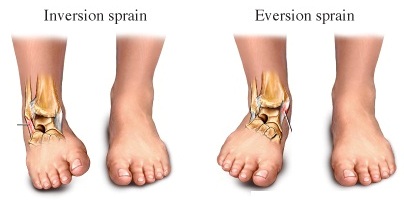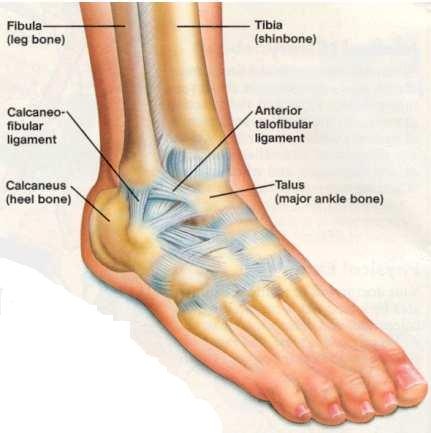 Ankle sprains can be classified by mild, moderate, or severe.
Ankle sprains can be classified by mild, moderate, or severe.
Mild cases of sprains:
- may be tender to the touch
- might have decrease in range of motion of the ankle joint
- might walk with a slight limp
- might show some signs of swelling.
Moderate cases of ankle sprains:
- tender or painful to the touch
- decrease range of motion of the ankle joint
- signs of limping
- signs of swelling and/or bruising.
Severe cases of ankle sprains:
- there might be signs of fracture
- very painful to the touch
- unable to move the ankle joint
- unable to walk on the foot/leg
- excessive swelling/bruising.
 The ankle joint is made up of three bones: the medial malleolus which is part of the tibia, the lateral malleolus which is part of the fibula, and the talus. Several tendons run along the ankle joint. The common tendons which may be injured as a result of an ankle sprain are the peroneus longus/brevis and tibialis anterior/posterior. In some severe cases the achilles tendon may be ruptured or injured. Several ligaments can be injured in the ankle joint, but the most common ligaments injured in an inversion sprain is the anterior talofibular and calcaneofibular ligaments.
The ankle joint is made up of three bones: the medial malleolus which is part of the tibia, the lateral malleolus which is part of the fibula, and the talus. Several tendons run along the ankle joint. The common tendons which may be injured as a result of an ankle sprain are the peroneus longus/brevis and tibialis anterior/posterior. In some severe cases the achilles tendon may be ruptured or injured. Several ligaments can be injured in the ankle joint, but the most common ligaments injured in an inversion sprain is the anterior talofibular and calcaneofibular ligaments.
At the first sign of an ankle injury assess the following to determine if there is a fracture or torn ligament or tendon:
- is there severe to uncontrollable pain
- is the injured person able to walk 4 steps, even if its a limp.
- is there severe pain with pressure along the sides of the ankle (medial/lateral malleolus)
- lost of sensation in the leg or foot
- severe bruising and/or swelling around the ankle joint especially the back of the ankle where the achille tendon is located.
- any pain along the sides of the leg or the calf area.
- any abnormal “lump” anywhere on the foot, ankle or leg
If any of the above symptoms or signs are present please seek emergency or professional consultation as soon as possible as there may be a fracture, contusion, and nerve damage. As this may require surgical repair or casting / bracing by a medical professional.
If there aren’t any of the above symptoms then conservative care at home and by a chiropractor can be taken.
During the first 24-48 hours these steps can be taken:
- Protect the injured area. Avoid any contact by other objects. A mild brace may be used.
- Rest the injured area. Avoid excessive walking and/or running. Lie down on the bed or rest the foot on a foot stool, etc.
- Ice the injured area. Applying ice for 15 minutes as needed with 60 minutes intervals to help reduce the initial inflammation/swelling/bruising of the ankle joint.
- Compress the injured area. Using a brace or supportive tape.
- Elevate the injured area. This allows the drainage of the swelling/bruising of the ankle.
- NSAIDs or Advil may be taken under supervision / direction of the medical doctor to reduce initial stages of inflammation and pain.
Treatment at the chiropractic office may consist of:
- Scar removal using Active Release Technique®. As scarring around the ankle joint may decrease future range of motion, and might predispose the ankle to future recurrent sprains.
- Adjustment of the ankle joint to break away scar tissue and realigning the ankle structure.
- Professional taping/ bracing of the ankle
- Passive and active range of motion of the ankle joint
- Tubing / strengthen exercises of the ankle joint
- Rocker board exercises to retrain the neurological receptors around the ankle joint
If you have any more questions about ankle injuries/prevention or treatment options please email Dr. Marcus Wong at drwong@truehealthstudio.com
